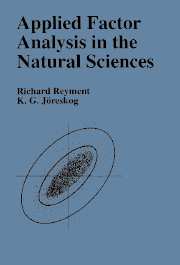Book contents
- Frontmatter
- Contents
- Preface
- Glossary of the most commonly used symbols
- Preface to first edition
- 1 Introduction
- 2 Basic Mathematical and Statistical Concepts
- 3 Aims, Ideas, and Models of Factor Analysis
- 4 R-Mode Methods
- 5 Q-Mode Methods
- 6 Q-R-Mode methods
- 7 Steps in the Analysis
- 8 Examples and Case Histories
- Appendix: Computer programs
- Bibliography
- Index
4 - R-Mode Methods
Published online by Cambridge University Press: 12 November 2009
- Frontmatter
- Contents
- Preface
- Glossary of the most commonly used symbols
- Preface to first edition
- 1 Introduction
- 2 Basic Mathematical and Statistical Concepts
- 3 Aims, Ideas, and Models of Factor Analysis
- 4 R-Mode Methods
- 5 Q-Mode Methods
- 6 Q-R-Mode methods
- 7 Steps in the Analysis
- 8 Examples and Case Histories
- Appendix: Computer programs
- Bibliography
- Index
Summary
INTRODUCTION
In this chapter we describe various methods suitable for studying the interrelationships among variables – so–called R-mode methods. In contrast, we treat in Chapter 5 Q-mode methods, which are designed for the study of interrelationships among objects.
In Chapter 3, we discussed the purposes, concepts, models, and terminology of factor analysis, a discussion that was put forward in terms of the population properties of the models. In practice, the data we have at our disposal consist of a sample drawn from the population. In the data matrix X, of order N × p, the rows constitute a random sample of observations from the population. From X one can compute the sample covariance matrix S, as we showed in Chapter 2. The statistical problem then is how does one go about estimating the population model from the data in X or S? In terms of the concepts of Chapter 3, we have the random case. The approach taken is that of fitting the population model to the data of the sample. However, even in the fixed case we need to fit a model to the data, since X or S will be approximated by matrices of lower rank. Some of the results are the same for the fixed and random cases. In the fixed case we are usually interested in estimating both the factor loadings matrix A and the factor scores matrix F, whereas in the random case, we are usually only interested in A and perhaps the covariance matrix Φ of the factors.
- Type
- Chapter
- Information
- Applied Factor Analysis in the Natural Sciences , pp. 89 - 135Publisher: Cambridge University PressPrint publication year: 1993

